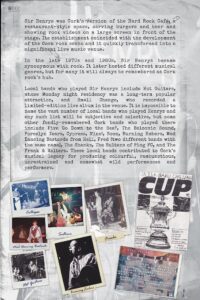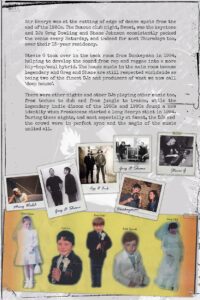Framing an exhibition – reflections from Sir Henrys@UCC Library
- Breeda Herlihy
- September 5, 2014
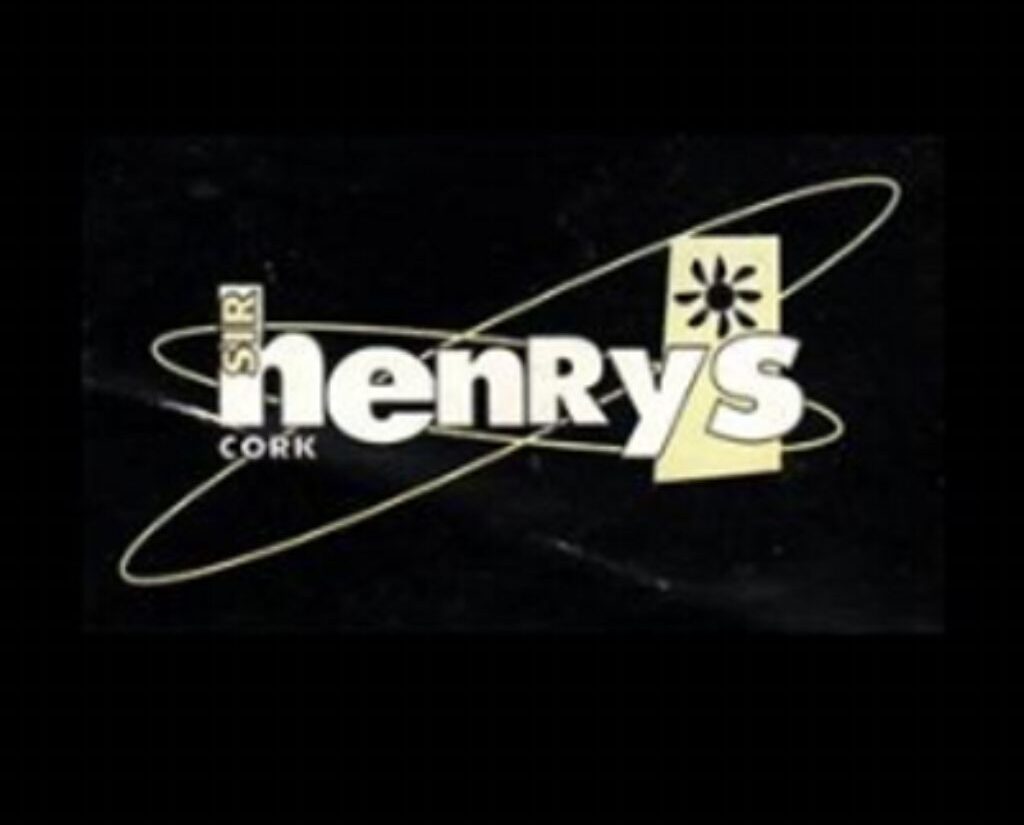
The River-side welcomes our UCC Library colleague Martin O’Connor for this guest post on his experience curating the exhibition “Sir Henrys@UCC Library”.
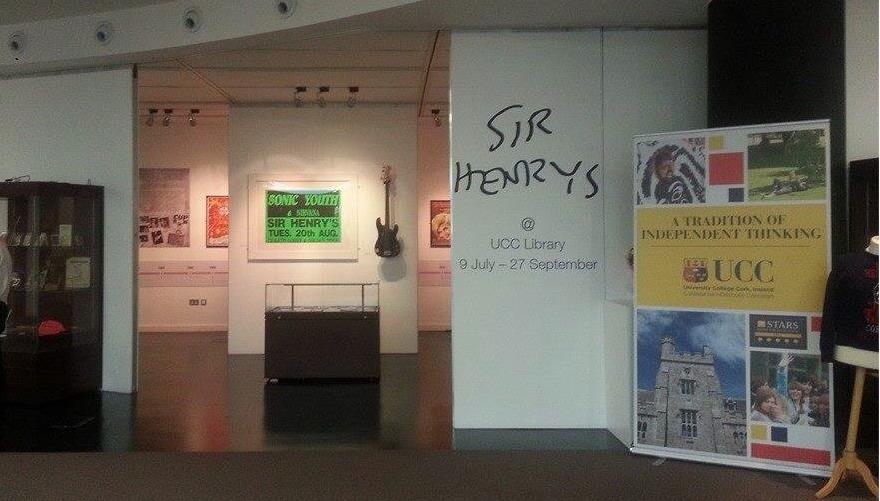
UCC Library is currently hosting an exhibition entitled SirHenrys @UCC Library that closes Saturday 27 September. The exhibition tells the story of the much loved, now defunct, Sir Henrys Bar and Nightclub, located South Main Street, Cork. This club was a vital part of Cork’s social, cultural and musical life from 1977-2003. It was renowned locally, nationally and internationally for its vibrant music scene – both rock and dance scenes – and the sense of community that these scenes inspired in those who attended the club on a regular basis.
The exhibition is very much a creation of the virtual, social media, world. It began with a simple tweet that turned into a discussion and evolved from there.
RT @examinerarts: Sweat + Sir Henrys has been done before, so good to focus on some lesser-known bits of the tale http://t.co/IgbOHjyMwj
— Irish Examiner (@irishexaminer) November 26, 2013
It was promoted primarily through the new media, specifically through the exhibition’s Twitter, Facebook and Blog accounts. And the actual items and material on show in the space, loaned by people who created the club, attended the club, worked in and ran the club, were garnered primarily through these networks. In essence the exhibition was crowdsourced. Or crowd harnessed as a comment on the exhibition comments’ book put it.
Literally over a thousand items spanning the beginning to the demise of the club was gathered. It is this material, and the whittling down to what was finally chosen for inclusion in the actual physical exhibition that the remainder of this post is concerned with. The remainder of the post is specifically a reflection on the selection process for the exhibit pieces and textual examples used in the exhibition. The post looks at the curating of the exhibition and the framing that is inherent in the act of curating.
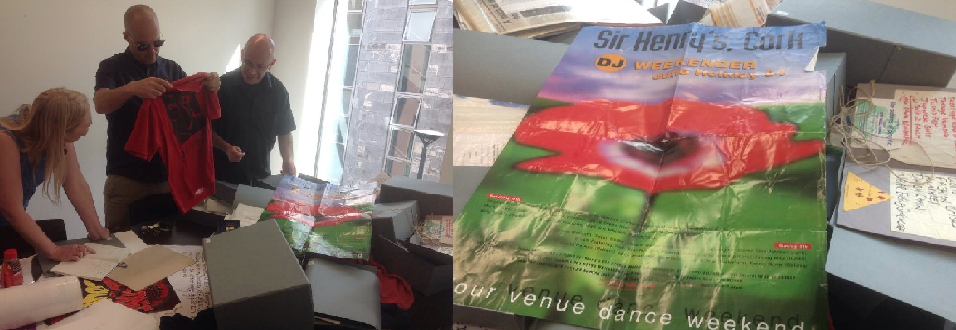
When selecting the actual material, with the other curators, that would go into the exhibit cases and feature on the storyboards I was reminded of a lecture I attended as a third year Sociology student. The module was Media Studies and the lecture had to do with the concept of ‘Framing’. Irish sociologist Ciaran McCullagh provides a succinct definition of what framing is and does:
“The basic argument about framing is that the media do not simply provide us with information on certain issues and events; they also provide us with perspectives on them. These place the events and issues within particular contexts and encourage audiences to understand them in particular ways. In effect, the media do not simply select events to cover; they also offer interpretative frameworks through which these are to understood”¹
Through choosing what items to include I became very aware that we as curators were in fact framing how ‘Sir Henrys the Club’ was going to be perceived in ‘Sir Henrys the Exhibition’. I was aware that we were not just presenting pieces in an exhibition in a neutral way. We were providing a particular perspective on Sir Henrys. As McCullagh says, we were creating an interpretative framework through which Henrys could be, and would be understood by those who came to visit the exhibition. This framing effect would be multiplied for those who never attended the club. For example for those students not born when the club was in existence they would be learning a very small part of the story and that story they learn is framed by what we decided to include in the physical exhibition space.
This is a particular issue when you consider that Sir Henrys existed as a club for over twenty-five years. Twenty-five years is time enough for many generations of club goers and many music scenes to have gone through its doors and climbed those infamous steps. How could we objectively condense twenty-five years into an intimate exhibition space? Would it be even possible to do so? Is it ever possible to do this?
Any one piece we chose to exhibit meant excluding another twenty or thirty pieces. Choosing a picture of one band meant leaving out countless others. Choosing to reference DJ V meant excluding DJs W, X, Y and Z. The act of curating by its very nature is an exclusionary exercise.
It becomes a further issue when you consider that this exhibition is taking place in a university library. This is problematic because the university is an institution that can bestow legitimacy upon objects.² When we chose an object we were elevating it above another. When we chose one band we were, tacitly, claiming they were more important than another. This is not something we took lightly.
The way we tried to get around the issue of framing was to use our virtual part of the exhibition – our social media aspects – Twitter, Blog, Facebook. These virtual sites are truly part of the exhibition. The social media side, for us, is as much a part of the exhibition as the physical space in the foyer of UCC Library. For us, the material on the Facebook page is a richer representation of what Sir Henrys was. It goes someway towards providing a true representation of what Sir Henrys was and remains to those who went there. The Sir Henrys Blog is alive with people’s memories and stories in the form of guest posts. These blog posts composed of people’s memories of Henrys captures Henrys and its spirit far better than a physical exhibition can. The countless stories, pictures and comments, tweets, blog posts provide a richer, far deeper representation, of what Sir Henrys was and remains to be for those who attended it.
Perhaps for a curator / curators to really represent an object or phenomenon they need to incorporate the virtual world? This virtual world, by its nature, provides a much larger canvas upon which to display the work.
Conclusion
The main lesson that I have learned from the process of curating this exhibition is to always ask the questions of who, how, why and what.
When I next attend an exhibition – whether that be in a museum, a gallery, a library or wherever, as well as enjoying the exhibition I will ask myself the following questions. Who did the choosing of the pieces contained within – what is their connection to the exhibit, who are they? How did they choose the pieces on show? How did they select them? Why did they choose these particular pieces as opposed to other pieces? What pieces are not on show? What pieces are lying in archive boxes? Or stored on shelves in some storeroom in the building? What pieces are not on show?
I will ultimately be asking what story is being told? How is this show framed?
The Sir Henrys@UCC Library Exhibition, curated by Stevie Grainger, Eileen Hogan and Martin O’Connor runs in the foyer of UCC Boole Library until Saturday September 27 2014.
More information can be found at:
Twitter
Facebook
WordPress Blog
References
¹ Ciaran McCullagh. 2002. Media Power: A Sociological Introduction. Hampshire: Palgrave.
² This is examined in a different way in another Sir Henrys related blog post.
